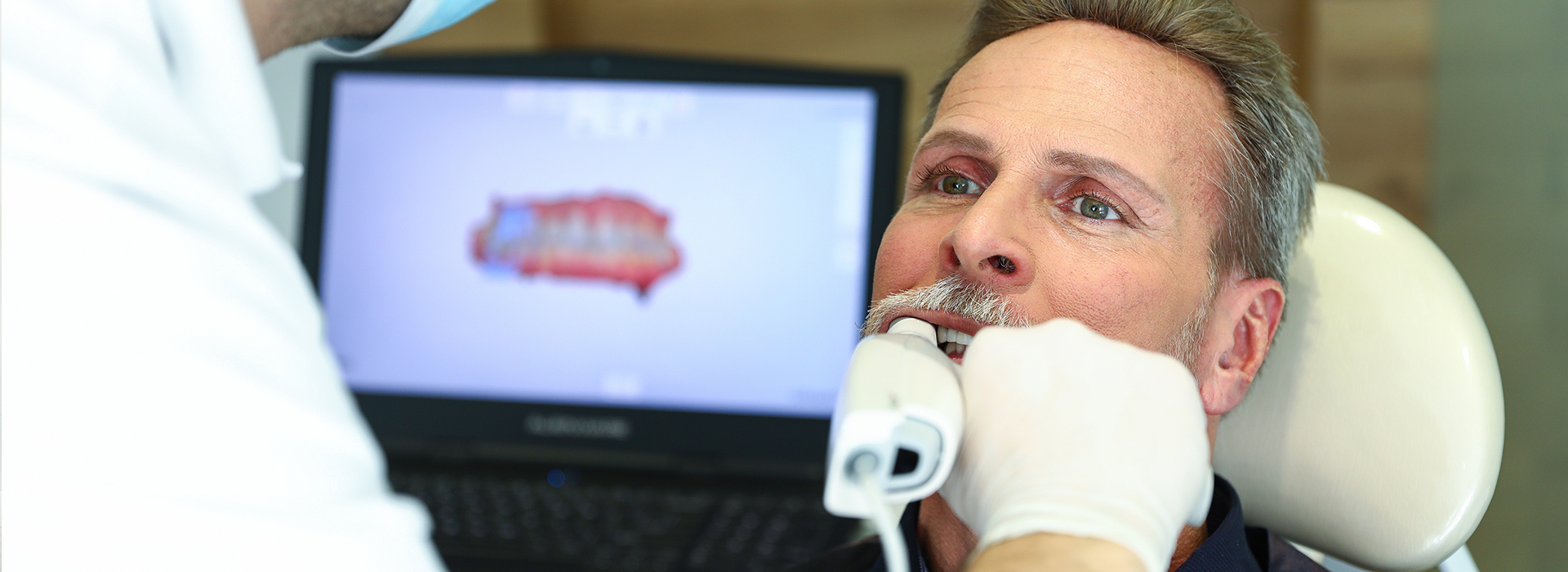New Patients
(865) 876-7050
Existing Patients
(865) 947-2220

Digital impressions have changed how dentists capture the shape and position of teeth and surrounding tissues. Instead of traditional trays and putty, clinicians use compact intraoral scanners to record highly detailed, three-dimensional images. These digital records can be reviewed on-screen in real time, refined instantly, and sent electronically to dental laboratories or used by in-office milling systems. At Kennedy Dentistry, we use digital impressions to streamline care and improve the predictability of restorative and cosmetic treatments.
Intraoral scanning uses a handheld wand that projects a pattern of light across teeth and soft tissues while tiny cameras or sensors read the reflected data. Specialized software stitches thousands of these individual images into a continuous, full-color 3D model. The result is a precise virtual replica of the mouth that can be rotated, measured, and inspected from any angle without re-taking physical molds.
The scanning process is dynamic: the clinician watches the model build on-screen as the wand moves, which allows for quick verification and targeted rescanning if an area needs more detail. Because the data are digital from the start, there’s no waiting for materials to set or for stone models to be poured — everything is available immediately for planning or transmission.
Beyond teeth, modern scanners capture surrounding soft tissues and occlusal relationships, which helps technicians and dentists design restorations that fit more comfortably and function more predictably. This comprehensive capture is particularly useful for crowns, bridges, implant restorations, and veneers where precise margins and contacts are essential.
One of the most noticeable advantages of digital impressions is patient comfort. Traditional impressions involve trays and viscous materials that can cause gagging, unpleasant tastes, and claustrophobic sensations for some people. Scanning removes those concerns by relying on a small, noninvasive wand that most patients find quick and unobtrusive.
Because the clinician can view the scan in real time, any missing detail is identified and corrected immediately, reducing the need for repeat appointments. This real-time feedback translates into shorter chair time overall and fewer surprises later in the restorative process. For patients who value efficiency or have difficulty tolerating long procedures, digital impressions can make a significant difference.
Digital files are also easily stored in a patient’s electronic record. When future work is needed, previous scans can be referenced to assess progression, compare changes, or plan follow-up treatment without subjecting the patient to another impression unless necessary.
Accuracy is the cornerstone of successful restorations, and digital impressions have proven capable of meeting high clinical standards. The multi-angle capture and software alignment reduce common distortions associated with material shrinkage or handling errors in traditional techniques. As a result, restorations fabricated from digital scans often require fewer adjustments at insertion.
Precision in the impression stage improves how a restoration seats against the prepared tooth, how it contacts neighboring teeth, and how it interfaces with implant components. That closer initial fit minimizes chairside modifications and helps the laboratory deliver work that adheres to the dentist’s prescription more faithfully.
When used in combination with digital design tools, such as CAD/CAM workflows, the scan becomes the starting point for a fully digital restorative chain. This integration supports more consistent aesthetic outcomes and predictable occlusion, which benefits both clinicians and patients through reduced appointment time and more reliable results.
One of the practical benefits of digital impressions is rapid, reliable communication with dental laboratories. Instead of shipping physical impressions that can be damaged or distorted, clinics transmit encrypted digital files directly to technicians. This electronic transfer reduces transit time, lowers the risk of data loss, and accelerates turnaround on crowns, bridges, and other prosthetics.
For practices equipped with in-office milling units, digital impressions enable same-day ceramic restorations. After a scan, the dental team can design the restoration digitally, mill it from a block of ceramic, and finish it during the same visit. This approach eliminates temporary restorations and multiple appointments for many single-unit cases, while preserving high-quality material options.
Even when work is completed by an external lab, the initial digital capture helps the technician visualize margin lines, occlusion, and tissue contours more clearly. Clear digital communication reduces ambiguity and supports a cooperative workflow that focuses on precise, timely results.
Your appointment begins with a straightforward scanning step after any necessary preparations, such as tooth isolation or dry field management. The clinician will move the scanner over the teeth and gums for a matter of minutes while the on-screen model builds. You can usually remain seated comfortably throughout, and the team will let you know if there are areas they would like to rescan for improved detail.
Following capture, the dentist reviews the 3D model with you when appropriate, pointing out relevant features and explaining how the data will inform treatment planning. Because the scan is immediate and detailed, you’ll often leave the appointment with a clear sense of next steps — whether that’s design and fabrication, scheduling for final restoration, or coordination with a lab.
Clinics that combine digital impressions with in-office fabrication may complete certain restorations the same day. For treatments that require laboratory collaboration, the digital files are sent electronically and the lab’s work proceeds without the delays associated with shipping physical models.
Digital impressions represent a modern, patient-centered approach to capturing oral anatomy that emphasizes comfort, accuracy, and efficient communication. By replacing messy materials with precise digital records, clinicians can plan and deliver restorations with fewer appointments and greater predictability. If you’d like to learn more about how digital impressions are used in our practice, please contact us for more information.
